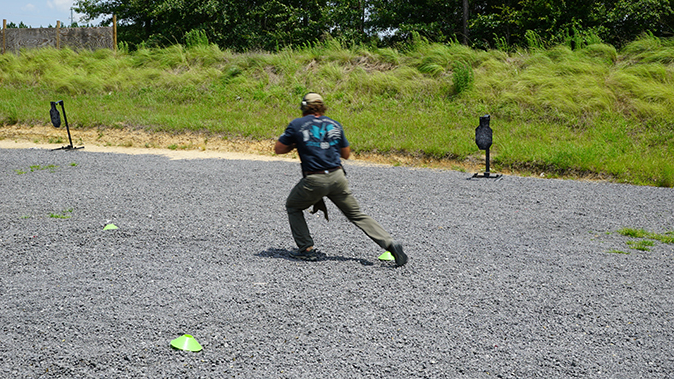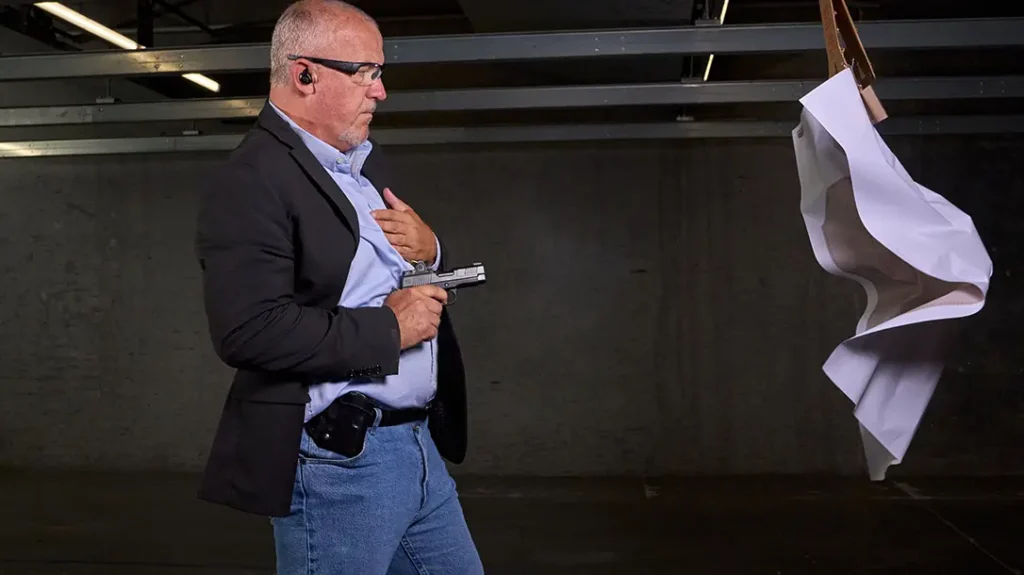It is hard to shoot a moving target. Being mobile is a natural defense mechanism that is built into our primal hard drive. A “square range” mindset is a sticking point with me during training. Too often, when I set up drills that require kinetics, guys are hesitant to move in varying directions with a gun in their hands. The administrative need to orient it downrange overrides the necessity to move naturally with a weapon system in hand. Is “stance” a fundamental of marksmanship when it comes to a gunfight? I would argue that “footing” more appropriately describes your foundation. We do not always get to choose where our feet are in relation to our body in a fight. Those who are hell bent on practicing a “fighting stance” on the square range are practicing for just that—the square range.
Don’t get me wrong. Flat range work is essential. Deep practice of the fundamentals until they can be performed at an intuitive level is absolutely necessary. Proper bullet placement and an acute understanding of gun handling and safety are paramount and should be performed with two feet flat on the ground while in a stationary position. But movement is necessary, too.
Advertisement — Continue Reading Below
Real-World Gunfight
Tactical shooting is more than target discrimination and proper bullet placement. It’s about eliminating predictability, surviving through mobility and being lethal. Remember that during training, you are replicating a possible shooting scenario. In a shooting, someone is typically shooting back at you. This guy has the same brain defaults that you have. You must make a determination when and where to move, and you must do this quickly. At the same time, you must know when to move fast and when to slow down. If you are missing your intended target, slow down. When moving from Point A to B, switch into high gear. After all, the objective when moving from one point to another is to get there. It is hard to shoot a moving target.
If you survive, you are a productive part of the team. You must be lethal to survive, and you must be mobile to be lethal. Mobility will reduce predictability.
Two things not practiced enough, or at all, on the range are proprioception and kinesthetic sense. Proprioception is the sense of the relative position of neighboring parts of the body and strength of effort being employed in movement, and kinesthetic sense helps us detect weight, body position and the relationship between movements in our body parts such as joints, muscles and tendons. In short, it is the muscle sense. It lets us know whether the body moves with effort and where the body parts are located in relation to other parts of the body.
Advertisement — Continue Reading Below
Kinesthetic sense is closely related to muscle memory, which is the memory that we possess due to constant repetition of a motor task, like signing your name or walking. Hand-eye coordination is also largely related to the sense of kinesthesia. This sense becomes automatic because of constant training.
Guys with little or no athletic background sometimes suck at this. They move like they’ve got a broomstick shoved up their asses. Movement should be smooth and martial-art like. When we are in motion, we tend to be more confident. Confidence and performance work hand-in-hand. Additionally, cognitive performance is increased when we are in motion.
We stand too flat-footed on a flat range and work with a flat-range mindset. Even incorporating small movements laterally and to the oblique front and rear will assist you in becoming more situationally aware of your body in the space it occupies.
Advertisement — Continue Reading Below
Can a 12-inch lateral move save your life? If you are face to face with a potentially lethal opponent (“potentially” only because he has not yet made a move), both of you are thinking about your next act. You are in a virtual chess match where a nanosecond can make the difference between life and death. Brain defaults will force you to make the first move—or to react—based on actions presented to you.
Adding A Step
At what point is the threat apparent enough that you should draw your pistol? And if you are standing stationary when you draw, why do we call it a “tactical drawstroke?” If you are standing stationary, you are not using tactics.
Advertisement — Continue Reading Below
A tactical drawstroke is commonly taught step-by-step in accordance with drawstroke doctrine. This doctrine is normally slightly modified from instructor to instructor. There is no magic to it, and there is nothing tactical about it. Why don’t we just call it what it is? It is a pistol draw. Adding “tactical” to an action or object adds sex appeal but does not change what it actually is.
Remember, if you are drawing a pistol, it is because someone dangerous is directly in front of you. It is an immediate, lethal threat. This bad guy is relying on your predictability and his defaults. His intentions are bad.
So here is my suggestion: Take a short lateral step to the left when performing your tactical drawstroke. It won’t slow your drawstroke down or throw you off balance. It will encourage your thought process (your brain works more efficiently when you are moving) and allow predictability to be minimized. Also, it will temporarily throw off your adversary, disrupting his OODA loop, which will buy you time and increase your lethality. In a gunfight, temporary is an eternity; being lethal is non-negotiable.
Advertisement — Continue Reading Below
Why step to the left? Ninety-three percent of the adult population is right-handed. In addition, most people can’t shoot. Most of them will jerk the trigger, which will lead them to hit low and left. Stepping right or left is not the important part. What matters is movement. Mobility equals survivability.
This article was originally published in the March/April issue of “Combat Handguns.” To order a copy and subscribe, visit outdoorgroupstore.com.































